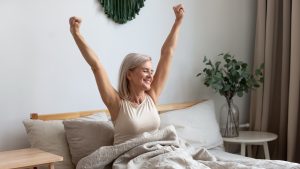
Patients living with osteoarthritis are often told to exercise to help reduce pain, but it becomes a deterrent for many who experience pain from the moment they start to move.
This pain during movement is the reason why patients with osteoarthritis aren’t more active. If this is not addressed, these people may end up in a loop of pain and inactivity that can lead to disability down the line.
Good Sleep Health
A growing body of research suggests that sleep may play an important role in reducing pain for people with osteoarthritis. This strong evidence has found a link between good quality sleep and being physically active.
Researchers believe that if you’re sleeping well, you’re more likely to be able to move more the next day and stick with a planned exercise program. Also, those who are more physically active are more likely to get a good night’s sleep.
Due to these findings, Daniel Whibley, Ph.D., research assistant professor of physical medicine and rehabilitation at Michigan Medicine and his team have developed a new intervention that brings together insights supporting the relationship between sleep and exercise.
Whibley said, “There are many different physical activity or exercise programs for people with osteoarthritis, but they spend relatively little time on sleep,” he said. “Conversely, some researchers have started to investigate the effectiveness of cognitive-behavioral therapy, the process of rooting out problematic thoughts and changing cognitive patterns, for insomnia as a way of reducing osteoarthritis-related pain.”
Whibley and his team analyzed two focus groups for the hybrid sleep-exercise program, composed of people living with osteoarthritis pain and sleep disturbances. These two groups helped form the program published in the British Journal of Pain and revealed that motivational language, personal accountability, and accessible educational materials were important aspects of a successful program.
More research is now being conducted, which will provide more insight into the relationship between sleep, physical activity and exercise, and how their balance can impact joint health and pain in this population. Researchers believe this program may hold great potential for the future of osteoarthritis-related pain management.